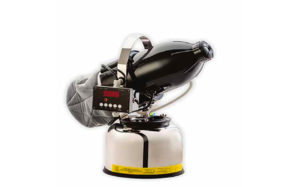Secure payment - Pay in 3 or 4 times with ALMA up to 3000€ TTC
Disinfection by dry fogging or Nebulisation is an airborne surface disinfection technique (DSVA: Disinfection of Surfaces by Air).
It consists of projecting a disinfectant product in very fine droplets into the atmosphere, using a device such as: MINIBIO S1 or MINIBIO S12,
Or our "flagship" device: JETBIO 2020 disinfection by fogging, which propels the disinfectant thanks to an air turbine "VORTEX with CISEAUX" has an output speed of 280 km/h. Propulsion distance 15 meters.

Our 100% "ORGANIC" airborne disinfection product is APABIO
The resulting disinfectant mist saturates the entire volume of the room and is then deposited on all surfaces in contact with the air.
They will therefore be disinfected, but not wet.
The product will start to act on the surfaces and destroy the microorganisms present on the surfaces: (floors, walls, cupboard tops, desks, chairs, computers, printers .......)
With our JETBIO 2020, the quantity of product is smaller, the contact time of the product and the drying time will be much shorter.
ATTENTION: We are not talking about air disinfection but surface disinfection.
The operation is either manual or automatic. Our misting devices are automatic, equipped with digital timers or manual.
Our digital timers allow you to set a delay time before the unit starts.
This allows operators to leave the room before the disinfection process begins and thus allows the surfaces of a room to be disinfected without human intervention.
With a regulated and controlled flow rate, these disinfection foggers ensure the dosage of the product automatically.
Simply start the programme and leave the room while the disinfectant is being sprayed. In addition, the disinfectant mist will act throughout the room, ensuring that all surfaces in the room that come into contact with the air are completely disinfected.
The (DSVA) (Disinfection of Surfaces by Air) is subject to the French standard for disinfection of surfaces by air, NF T 72-281, which attests to its effectiveness.
We advise to use very powerful devices in terms of disinfectant propulsion. The more powerful the device, the shorter the fogging or nebulising time.
As a result, product consumption will be reduced.
On average, a low-powered device consumes 6 times more product than our JETBIO 2020 VORTEX" turbine appliance
According to the current standards, a disinfection machine consumes about 16 ml of product per minute.
A low-powered machine will take 6 to 7 times longer to saturate the volume of the room with product and will therefore consume 6 to 7 times more disinfectant.
With our powerful JETBIO 2020 you will only need 120 ml of product and 10 minutes of propulsion to disinfect a room of 100 m3
Our disinfection devices are quick and easy to program. They guarantee effective disinfection results for communities (crèches, retirement homes, etc.), medical practices, laboratories, public transport, the food industry and all sectors that require disinfection in accordance with current standards.
On the market and during the crisis of COVID, the products of "Chinese" manufacture invaded the French market. It is important to know that these foggers are not devices designed for disinfection but for disinsectization. Disinsectisation does not require, contrary to disinfection, to have fine droplets. Indeed, the devices of disinsectisation will rather wet the surfaces so that the active principle of the product touches and makes effect on the insects.
To compare, the size of the droplets of a disinfectant spray is 5µ, those of a disinfectant spray are 30µ, i.e. 6 times larger and will leave a wet surface.
Chinese foggers do not allow droplet sizes fine enough to saturate a volume of air. The droplets are much larger than 15 microns and fall very quickly to the ground, forming puddles that can damage the materials present.